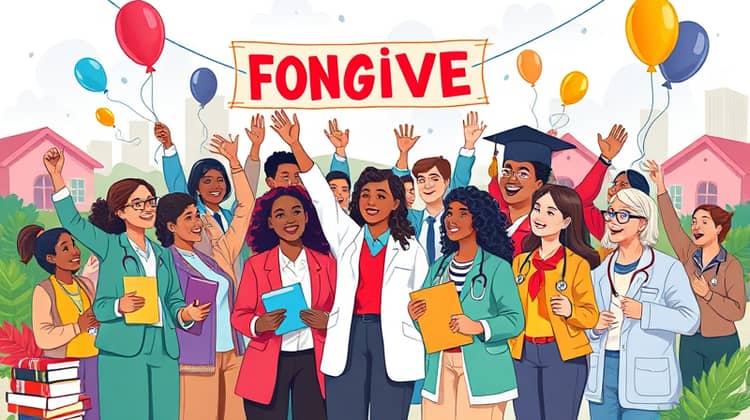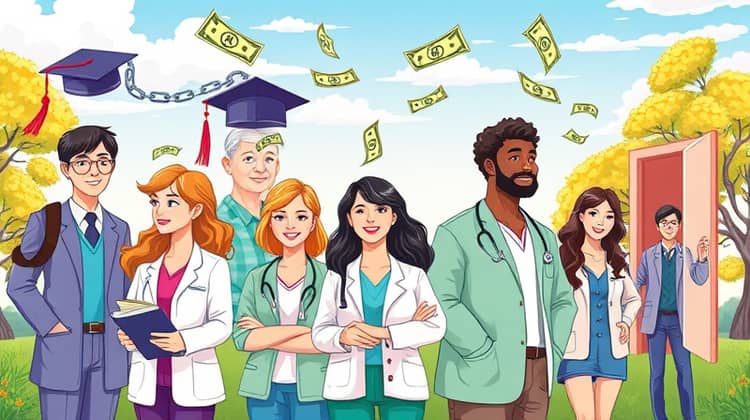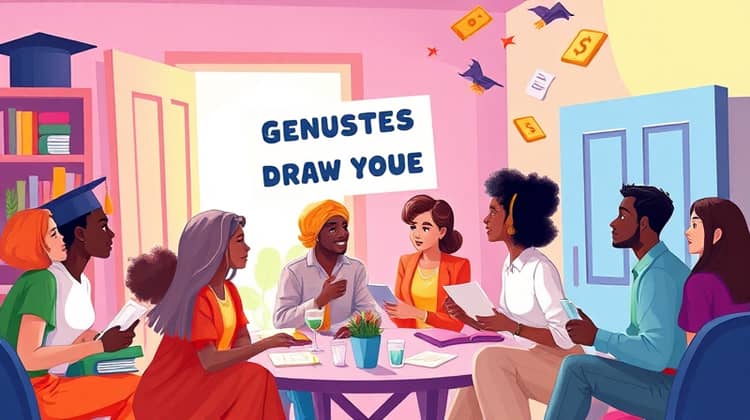Loan Forgiveness Programs: Are You Missing Out on Relief Opportunities?

In recent years, student loan debt has reached staggering levels, affecting millions of borrowers nationwide. As many individuals struggle to keep up with their monthly payments, aware of their burdens, loan forgiveness programs become lifelines for those seeking relief. This blog post explores different loan forgiveness options available, shedding light on qualifications and application processes, ensuring you don't miss out on the opportunities that can provide substantial relief.
Understanding the various loan forgiveness programs allows you to navigate this complex landscape effectively. Each program has unique criteria and benefits tailored to specific professions and practices. Whether you're a teacher, public health worker, or simply facing financial hardship, knowing your options can empower you to take the necessary steps towards alleviating your debt burden.
In this guide, we will break down the different types of forgiveness programs, eligibility requirements, and how to apply, giving you all the information you need to make an informed decision regarding your student loans.
What is Loan Forgiveness?

Loan forgiveness refers to the cancellation of some or all of a borrower's student loans. This helpful provision often targets individuals who have dedicated their careers to public service or specific sectors that support communities. Loan forgiveness programs are designed to reduce the debt burden for borrowers who meet specific criteria, providing financial relief and opening doors to new opportunities.
To qualify for loan forgiveness, borrowers generally need to make consistent payments over a set period while working in qualifying employment. Certain programs may also require borrowers to demonstrate financial hardship or other situational factors influencing their capacity to repay their loans. Understanding these qualifications is crucial for anyone seeking loan forgiveness.
The federal government, as well as private organizations, offer a variety of loan forgiveness programs, each designed to serve different populations and needs. Navigating these options effectively can empower individuals to take control of their financial futures.
Types of Loan Forgiveness Programs

There are several types of loan forgiveness programs available for borrowers. Each program targets specific professions or circumstances, creating various paths for individuals to seek relief from their student loan debts. Familiarizing yourself with these options is the first step towards achieving financial peace.
In most cases, borrowers must meet specific eligibility requirements to qualify for a forgiveness program. Some programs may grant forgiveness after a certain number of payments, while others target specific job roles or professional sectors. Here are some well-known types of loan forgiveness programs:
- Public Service Loan Forgiveness (PSLF)
- Teacher Loan Forgiveness
- Income-Driven Repayment Plan Forgiveness
- Closed School Discharge
- Borrower Defense to Repayment
Understanding the different types of loan forgiveness programs is critical, as they can significantly reduce your financial obligations. By exploring these options, borrowers can work towards achieving a brighter, debt-free future.
Public Service Loan Forgiveness (PSLF)

Public Service Loan Forgiveness (PSLF) is a program designed for individuals working in government or nonprofit sectors. To qualify, borrowers must make 120 qualifying monthly payments under a qualifying repayment plan while employed full-time in a public service role. After meeting these requirements, the remaining balance on their Direct Loans is forgiven.
The PSLF program particularly benefits teachers, nurses, public defenders, and social workers, among others. However, it is vital for borrowers to maintain meticulous records of their employment and payments to ensure smooth application processing after the 120 payments are completed.
Teacher Loan Forgiveness

Teacher Loan Forgiveness targets educators who work in low-income schools or subject areas with teacher shortages. Eligible teachers may qualify for forgiveness of up to $17,500 after five consecutive years of service. This program aims to recruit and retain high-quality teachers where they are most needed, thus benefiting students and communities alike.
To qualify, teachers must meet several criteria, including teaching in a designated low-income school and holding certain types of loans. Understanding these requirements can lead to substantial savings and ease the financial strain of being an educator.
Income-Driven Repayment Plan Forgiveness

Income-Driven Repayment (IDR) plans allow borrowers to manage their monthly payments based on their income and family size. If borrowers remain on these plans for 20 to 25 years, any remaining balance may be forgiven. IDR plans provide a safety net for borrowers facing financial hardships, ensuring they aren't overwhelmed by their loan payments.
This forgiveness option is particularly beneficial for those entering lower-paying jobs or who experience economic difficulties during their repayment period. Evaluating your income and navigating these plans can offer immense relief for struggling borrowers.
Closed School Discharge

Closed School Discharge offers forgiveness to borrowers whose schools closed before they could complete their programs. If students attended a school that closed while they were enrolled or within 120 days of withdrawing, they might qualify for loan discharge based on the school's closure. This provision ensures that students who were pursuing their education are not held liable for loans taken out for programs they could not complete.
It is essential for borrowers to keep records of their enrollment and any communications regarding their school's closure to ensure they can access the financial relief they are entitled to.
Borrower Defense to Repayment

Borrower Defense to Repayment is a key protection for students misled by their schools in terms of the quality of education, job placement rates, or other critical information. If a borrower believes that their school engaged in fraudulent behavior, they can apply for loan discharge under this provision.
This program serves as a vital means for borrowers to reclaim their financial footing after potentially life-altering experiences with misleading educational institutions, providing hope and healing for those in need. To succeed in this process, borrowers should gather all relevant documentation demonstrating the circumstances surrounding their enrollment.
Are You Eligible?

Determining your eligibility for loan forgiveness is crucial to take advantage of these valuable opportunities. Each program has specific criteria you must meet, emphasizing the importance of understanding these details before applying. Carefully reviewing the requirements can streamline your application process and improve your chances of success.
Common eligibility indicators include employment in a qualifying position, consistent repayment history, and overall financial condition. Additionally, some programs cater specifically to certain disciplines or public service sectors, further shaping eligibility.
Ultimately, assessing your situation in relation to these criteria empowers you to make informed decisions regarding your student loans, guiding your journey towards financial freedom.
General Eligibility Criteria
While specific requirements differ across forgiveness programs, there are some general criteria applicable to most of them.
- Must be a U.S. citizen or eligible non-citizen
- Must have federal student loans
- Must be in good standing regarding loan repayment
Reviewing these general criteria can aid you as you explore various loan forgiveness opportunities. Familiarity with these basics is your key to unlocking substantial financial relief.
Program-Specific Requirements
Each loan forgiveness program has unique requirements that borrowers must fulfill to qualify. Thoroughly understanding these specifications is essential to determine the best fit for your situation. For instance, PSLF necessitates 120 qualifying payments and employment in public service, while Teacher Loan Forgiveness requires five years of teaching in low-income schools.
It is crucial to consult official resources or a financial advisor who can provide personalized guidance as you navigate these specific requirements. Ensuring your eligibility maximizes your chances of successfully securing forgiveness.
How to Apply?

Applying for loan forgiveness typically involves a series of steps that require careful attention to detail. First, you should identify which program best suits your needs, ensuring you meet all requirements. Once you have determined the appropriate program, gather all necessary documentation, including proof of employment and loan history.
Next, each program may have a different application process. Applications for PSLF, for example, can be submitted directly through the loan servicer or by utilizing the PSLF Help Tool available online. It’s important to follow each program's instructions closely to avoid any missteps.
Lastly, don’t forget to maintain copies of your completed applications and relevant communications with your loan servicer. This ensures you have a record of your submissions as you continue to monitor the status of your application.
Conclusion

Understanding loan forgiveness programs is essential for those seeking relief from the burden of student loan debt. By exploring different options, assessing eligibility criteria, and navigating application processes, borrowers can proactively work towards financial freedom.
Don't miss out on the valuable resources available to you; take the time to assess your situation and research the programs that cater to your unique needs. The road to financial relief may be challenging, but with the right information and support, it is achievable.
Empower yourself with knowledge and take that first step towards a debt-free future—your financial well-being depends on it.






